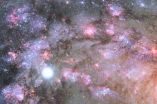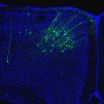(Press-News.org) Elliptical galaxies are large, gas-poor gatherings of older stars and are one of the main types of galaxy along with their spiral and lenticular relatives. Galaxy formation theories suggest that giant elliptical galaxies form from the inside out, with a large core marking the very first stages of formation.
However, evidence of this early construction phase has eluded astronomers — until now.
Astronomers have now spotted a compact galactic core known as GOODS-N-774, and nicknamed Sparky [1]. It is seen as it appeared eleven billion years ago, just three billion years after the Big Bang.
"This core formation process is a phenomenon unique to the early Universe," explains Erica Nelson of Yale University, USA, lead author of the science paper announcing the results, "we do not see galaxies forming in this way any more. There's something about the Universe at that time that could form galaxies in this way that it now can't. We suspect that the Universe could produce denser objects because the Universe as a whole was denser shortly after the Big Bang. It is much less dense now, so it can't do it anymore."
Although only a fraction of the size of the Milky Way, the infant galaxy is crammed with so many young stars that it already contains twice as much mass as our entire galaxy. It is thought that the fledgling galaxy will continue to grow, eventually becoming a giant elliptical galaxy. The astronomers think that this barely visible galaxy may be representative of a much larger population of similar objects that are too faint or obscured by dust to be spotted — just like the Sun can appear red and faint behind the smoke of a forest fire.
Alongside determining the galaxy's size from the Hubble images, the team dug into archival far-infrared images from NASA's Spitzer Space Telescope and the ESA Herschel Space Observatory to see how fast the compact galaxy is churning out stars. GOODS-N-774 is producing 300 stars per year. "By comparison, the Milky Way produces thirty times fewer than this — roughly ten stars per year," [2] says Marijn Franx of Leiden University in the Netherlands, a co-author of the study. "This star-forming rate is really intense!"
This tiny powerhouse contains about twice as many stars as our galaxy, all crammed into a region only 6000 light-years across. The Milky Way is about 100 000 light-years across.
Astronomers believe that this frenzied star formation occurs because the galactic centre is forming deep inside a gravitational well of dark matter, an invisible form of matter that makes up the scaffolding upon which galaxies formed in the early Universe. A torrent of gas is flowing into the well and into the compact galaxy, sparking waves of star birth.
"They're very extreme environments," said Nelson. "It's like a medieval cauldron forging stars. There's a lot of turbulence, and it's bubbling. If you were in there, the night sky would be bright with young stars, and there would be a lot of dust, gas, and remnants of exploding stars. To actually see this happening is fascinating."
The sheer amount of gas and dust within an extreme star-forming region like this may explain why they have eluded astronomers until now. Bursts of star formation create dust, which builds up within the forming core and can block some starlight [3] — GOODS-N-774 was only just visible, even using the resolution and infrared capabilities of Hubble's Wide Field Camera 3.
"This galaxy seems to have been furiously forming stars for more than a billion years," adds Franx. "We have spotted it very early on in its life. Shortly after the time period we're looking at, we think that this core will have stopped forming stars, and that smaller galaxies will have merged with it over the next 10 billion years until it expanded and grew outwards in size. It would resemble one of the mammoth, sedate ellipticals we see today."
"We had been searching for this galaxy for years, and it's very exciting that we finally found it", says Dokkum, "The big challenge is to understand the physics driving the formation of such objects. The James Webb Space Telescope, Hubble's successor, will be able to help us find an answer."
INFORMATION:
Notes
[1] The astronomers found the galaxy while poring over WFC3 images of thousands of galaxies catalogued in two large Hubble surveys of the distant Universe: 3D-HST and the Cosmic Assembly Near-infrared Deep Extragalactic Legacy Survey (CANDELS). They then used instruments at the W.M. Keck Observatory to measure the galaxy's distance from Earth, and to detect how fast the gas was moving, which confirmed its massive structure.
[2] Not all stars are the same mass as our Sun. The approximately 10 stars per year formed in the Milky Way will generally be less massive than our Sun.
[3] The dust build up in the compact galaxy obscures and reddens ultraviolet light from infant stars. The dust is absorbing and re-radiating that light as infrared light.
Notes for editors
The Hubble Space Telescope is a project of international cooperation between ESA and NASA.
The science paper announcing the results will appear in the journal Nature on 27 August 2014. The international team of astronomers in this study consists of E. Nelson (Yale University, USA), P. van Dokkum (Yale University, USA), M. Franx (Leiden University, The Netherlands), G. Brammer (STScI, USA), I. Momcheva (Yale University, USA), N. M. Forster Schreiber (Max Planck Institute for Extraterrestrial Physics, Garching, Germany), E. da Cunha (Max Planck Institute for Astronomy, Heidelberg, Germany), L. Tacconi (Max Planck Institute for Extraterrestrial Physics, Garching, Germany), R. Bezanson (University of Arizona, USA), A. Kirkpatrick (University of Massachusetts, USA), J. Leja (Yale University, USA), H-W. Rix (Max Planck Institute for Astronomy, Heidelberg, Germany), R. Skelton (SAAO, South Africa), A. van der Wel (Max Planck Institute for Astronomy, Heidelberg, Germany), K. Whitaker (Goddard Space Center, USA), and S. Wuyts (Max Planck Institute for Extraterrestrial Physics, Garching, Germany).
More information
Image credit: NASA, ESA, and E. Nelson (Yale University)
Links
Images of Hubble: http://www.spacetelescope.org/images/archive/category/spacecraft/
STScI release: http://hubblesite.org/newscenter/archive/releases/2014/37/
Science paper: http://www.spacetelescope.org/static/archives/releases/science_papers/heic1418a.pdf
Contacts
Erica Nelson
Yale University
New Haven, Connecticut, USA
Tel: +1-203-432-0573
Email: erica.nelson@yale.edu
Marijn Franx
Leiden Observatory
Leiden University, The Netherlands
Tel: +31 71 527 5870
Email: franx@strw.leidenuniv.nl
Pieter van Dokkum
Yale University
New Haven, Connecticut, USA
Email: pieter.vandokkum@yale.edu
Georgia Bladon
ESA/Hubble, Public Information Officer
Garching bei München, Germany
Tel: +44 7816 291261
Email: gbladon@partner.eso.org
Witnessing the early growth of a giant
First ever sighting of galaxy core formation
2014-08-27
ELSE PRESS RELEASES FROM THIS DATE:
Stop and listen: Study shows how movement affects hearing
2014-08-27
DURHAM, N.C. -- When we want to listen carefully to someone, the first thing we do is stop talking. The second thing we do is stop moving altogether. This strategy helps us hear better by preventing unwanted sounds generated by our own movements.
This interplay between movement and hearing also has a counterpart deep in the brain. Indeed, indirect evidence has long suggested that the brain's motor cortex, which controls movement, somehow influences the auditory cortex, which gives rise to our conscious perception of sound.
A new Duke study, appearing online August 27 ...
NASA sees massive Marie close enough to affect southern California coast
2014-08-27
Two NASA satellites captured visible and infrared pictures that show the massive size of Hurricane Marie. Marie is so large that it is bringing rough surf to the southern coast of California while almost nine hundred miles west of Baja California.
On August 26 at 19:05 UTC (3:05 p.m. EDT) NASA's Terra satellite captured a visible image of Hurricane Marie drawing in the small remnants of Karina. Marie is over 400 miles in diameter, about the distance from Washington, D.C. to Boston, Massachusetts. Hurricane force winds extend outward up to 60 miles (95 km) from the center ...
Scripps Research Institute scientists link alcohol-dependence gene to neurotransmitter
2014-08-27
LA JOLLA, CA – August 27, 2014 – Scientists at The Scripps Research Institute (TSRI) have solved the mystery of why a specific signaling pathway can be associated with alcohol dependence.
This signaling pathway is regulated by a gene, called neurofibromatosis type 1 (Nf1), which TSRI scientists found is linked with excessive drinking in mice. The new research shows Nf1 regulates gamma-aminobutyric acid (GABA), a neurotransmitter that lowers anxiety and increases feelings of relaxation.
"This novel and seminal study provides insights into the cellular mechanisms of ...
Expression of privilege in vaccine refusal
2014-08-27
DENVER (August 27, 2014) – Not all students returning to school this month will be up to date on their vaccinations. A new study conducted by Jennifer Reich, a researcher at the University of Colorado Denver, shows that the reasons why children may not be fully vaccinated depends on the class privilege of their mothers.
According to the National Network for Immunization Information, three children per 1000 in the U.S. have never received any vaccines, with almost half of all children receiving vaccines later than recommended. The number of unvaccinated children has led ...
Dosage of HIV drug may be ineffective for half of African-Americans
2014-08-27
Many African-Americans may not be getting effective doses of the HIV drug maraviroc, a new study from Johns Hopkins suggests. The initial dosing studies, completed before the drug was licensed in 2007, included mostly European-Americans, who generally lack a protein that is key to removing maraviroc from the body. The current study shows that people with maximum levels of the protein — including nearly half of African-Americans — end up with less maraviroc in their bodies compared to those who lack the protein even when given the same dose. A simple genetic test for the ...
Scientists plug into a learning brain
2014-08-27
Learning is easier when it only requires nerve cells to rearrange existing patterns of activity than when the nerve cells have to generate new patterns, a study of monkeys has found. The scientists explored the brain's capacity to learn through recordings of electrical activity of brain cell networks. The study was partly funded by the National Institutes of Health.
"We looked into the brain and may have seen why it's so hard to think outside the box," said Aaron Batista, Ph.D., an assistant professor at the University of Pittsburgh and a senior author of the study published ...
Pitt and Carnegie Mellon engineers discover why learning can be difficult
2014-08-27
PITTSBURGH—Learning a new skill is easier when it is related to ability that we already possess. For example, a trained pianist might learn a new melody more easily than learning how to hit a tennis serve.
Neural engineers from the Center for the Neural Basis of Cognition (CNBC)—a joint program between the University of Pittsburgh and Carnegie Mellon University—have discovered a fundamental constraint in the brain that may explain why this happens. Published as the cover story in the Aug. 28, 2014, issue of Nature, they found for the first time that there are constraints ...
Kessler Foundation scientists study impact of cultural diversity in brain injury research
2014-08-27
West Orange, NJ. August 27, 2014. Kessler Foundation scientists examined the implications for cultural diversity and cultural competence in brain injury research and rehabilitation. The article by Anthony Lequerica, PhD, and Denise Krch, PhD: Issues of cultural diversity in acquired brain injury (ABI) rehabilitation (doi:10.3233/NRE-141079) was published by Neurorehabilitation. Drs. Lequerica and Krch are research scientists in Traumatic Brain Injury (TBI) Research at Kessler Foundation and co-investigators for the Northern New Jersey TBI Model System.
Cultural sensitivity ...
New smartphone app can detect newborn jaundice in minutes
2014-08-27
Newborn jaundice: It's one of the last things a parent wants to deal with, but it's unfortunately a common condition in babies less than a week old.
Skin that turns yellow can be a sure sign that a newborn is jaundiced and isn't adequately eliminating the chemical bilirubin. But that discoloration is sometimes hard to see, and severe jaundice left untreated can harm a baby.
University of Washington engineers and physicians have developed a smartphone application that checks for jaundice in newborns and can deliver results to parents and pediatricians within minutes. ...
Parents, listen next time your baby babbles
2014-08-27
Pay attention, mom and dad, especially when your infant looks at you and babbles.
Parents may not understand a baby's prattling, but by listening and responding, they let their infants know they can communicate which leads to children forming complex sounds and using language more quickly.
That's according to a new study by the University of Iowa and Indiana University that found how parents respond to their children's babbling can actually shape the way infants communicate and use vocalizations.
The findings challenge the belief that human communication is innate ...
LAST 30 PRESS RELEASES:
Decoupling the HOR enhancement on PtRu: Dynamically matching interfacial water to reaction coordinates
Sulfur isn’t poisonous when it synergistically acts with phosphine in olefins hydroformylation
URI researchers uncover molecular mechanisms behind speciation in corals
Chitin based carbon aerogel offers a cleaner way to store thermal energy
Tracing hidden sources of nitrate pollution in rapidly changing rural urban landscapes
Viruses on plastic pollution may quietly accelerate the spread of antibiotic resistance
Three UH Rainbow Babies & Children’s faculty elected to prestigious American Pediatric Society
Tunnel resilience models unveiled to aid post-earthquake recovery
Satellite communication systems: the future of 5G/6G connectivity
Space computing power networks: a new frontier for satellite technologies
Experiments advance potential of protein that makes hydrogen sulfide as a therapeutic target for Alzheimer’s disease
Examining private equity’s role in fertility care
Current Molecular Pharmacology achieves a landmark: real-time CiteScore advances to 7.2
Skeletal muscle epigenetic clocks developed using postmortem tissue from an Asian population
Estimating unemployment rates with social media data
Climate policies can backfire by eroding “green” values, study finds
Too much screen time too soon? A*STAR study links infant screen exposure to brain changes and teen anxiety
Global psychiatry mourns Professor Dan Stein, visionary who transformed mental health science across Africa and beyond
KIST develops eco-friendly palladium recovery technology to safeguard resource security
Statins significantly reduce mortality risk for adults with diabetes, regardless of cardiovascular risk
Brain immune cells may drive more damage in females than males with Alzheimer’s
Evidence-based recommendations empower clinicians to manage epilepsy in pregnancy
Fungus turns bark beetles’ defenses against them
There are new antivirals being tested for herpesviruses. Scientists now know how they work
CDI scientist, colleagues author review of global burden of fungus Candida auris
How does stroke influence speech comprehension?
B cells transiently unlock their plasticity, risking lymphoma development
Advanced AI dodel predicts spoken language outcomes in deaf children after cochlear implants
Multimodal imaging-based cerebral blood flow prediction model development in simulated microgravity
Accelerated streaming subgraph matching framework is faster, more robust, and scalable
[Press-News.org] Witnessing the early growth of a giantFirst ever sighting of galaxy core formation







